An Enhanced Approach for Urban Sustainability Considering Coordinated Source-Load-Storage in Distribution Networks Under Extreme Natural Disasters
Abstract
1. Introduction
1.1. Research Background
1.2. Literature Review
1.2.1. Pre-Disaster Prevention Strategies
1.2.2. Resilience Enhancement Strategies in Disasters
1.2.3. Disaster Recovery Strategies
1.3. Research Gaps and Contributions
- A power restoration method based on post-disaster topology reconfiguration is proposed. By analyzing damage characteristics of the distribution network, a restoration model is constructed, and a rapid reconfiguration strategy coordinated with source-load-storage is designed to achieve prioritized restoration of critical loads and grid connection of power sources, laying the foundation for subsequent voltage optimization.
- Based on the power supply, a voltage optimization method for highly resilient distribution networks is proposed. After post-disaster power restoration, the method leverages source-load-storage coordination to flexibly utilize reactive power compensation devices and the remaining flexible resources to optimize voltage, thereby improving power quality and restoration efficiency in the distribution system, which in turn enhances the sustainability of urban development.
- Based on the voltage sensitivity coefficient, an allocation method for flexible resources is developed. Centered on multi-source heterogeneous resources such as reactive power compensation devices, mobile emergency generators, centralized energy storage, and electric vehicles, differentiated dispatch strategies are designed to enable precise deployment and efficient utilization of flexible resources, further enhancing the voltage regulation capability and economic performance of the post-disaster power system.
2. Two-Stage Dispatch Framework for Distribution Networks Considering Source-Load-Storage Coordination
2.1. Optimal Dispatch Scenario of Distribution Networks with Source-Load-Storage Coordination
2.2. Optimization Framework for Distribution Network Dispatch with Source-Load-Storage Coordination
- Power Supply Module: After an extreme natural disaster occurs, the distribution network is reconfigured based on damage assessment results. Priority is given to restoring power to critical loads and important nodes to ensure the basic operational capability of the system, thereby providing foundational support for subsequent voltage sensitivity analysis and voltage optimization.
- Voltage Sensitivity Calculation Module: After the power supply is completed, power flow analysis is conducted on the reconfigured topology. Voltage sensitivity coefficients are then calculated using the Jacobian matrix inversion method, which is used to determine the dispatch priority of different flexible resources in the voltage optimization process. Notably, the Jacobian matrix is derived from the Newton–Raphson power flow algorithm. Therefore, when assessing voltage sensitivity, its inverse offers a linear approximation of voltage responses. This method is computationally efficient for large-scale systems due to the matrix’s sparsity, reusability, localized updates, and scalability.
- Voltage Optimization Module: Based on the established dispatch priorities, resources with higher priority are utilized to perform voltage optimization, with the dual objective of minimizing voltage fluctuations and optimization costs, thereby improving voltage quality and enhancing distribution network resilience.
3. Power Supply Model for Distribution Networks Based on Source-Load-Storage Coordination
3.1. Objective Function of Power Supply Model
3.2. Constraint Conditions of Power Supply Model
4. Priority Determination Method for Flexible Resources Based on Voltage Sensitivity Calculation
4.1. Power Flow Calculation Method
- (1)
- Set the initial values (0) and (0);
- (2)
- Based on the initial values, calculate the mismatch vectors and ;
- (3)
- Compute the Jacobi matrix ;
- (4)
- Solve the correction equation to obtain the corrections (0) and (0);
- (5)
- Update the variables:(1) = (0) + (0), (1) = (0) + (0);
- (6)
- Check convergence: if max|(0), (0)| < , stop; otherwise, return to step (2) and repeat the iteration.
4.2. Method for Voltage Sensitivity Calculation and Priority Determination
5. Voltage Optimization Model for Distribution Networks Based on Source-Load-Storage Coordination
5.1. Objective Function of Voltage Optimization Model
5.2. Constraint Conditions of Voltage Optimization Model
5.3. Solution Process
6. Case Studies
6.1. Parameter Settings
6.2. Comparative Analysis of Power Supply Performance Under Different Strategies
6.3. Determination of Dispatch Priority for Flexible Resources
6.4. Comparative Analysis of Voltage Optimization Performance Under Different Strategies
7. Conclusions
- The proposed two-layer post-disaster optimization model incorporates a voltage regulation stage following power restoration. It enables precise regulation tailored to the voltage quality requirements of critical loads, thereby effectively enhancing system resilience and operational reliability.
- The voltage optimization model based on voltage sensitivity coefficients demonstrates strong economic performance and adaptability. By prioritizing resources with greater contributions to voltage regulation, the model ensures voltage quality while significantly reducing optimization costs and improving system resilience. It is particularly effective in scenarios with limited reactive power resources.
Author Contributions
Funding
Institutional Review Board Statement
Informed Consent Statement
Data Availability Statement
Conflicts of Interest
References
- Lin, X.; Huang, T.; Liu, X.; Bompard, E.F.; Wang, B. A long-term congestion management framework through market zone configuration considering collusive bidding in joint spot markets. IEEE Trans. Power Syst. 2024, 40, 299–313. [Google Scholar] [CrossRef]
- Rabiee, A.; Mohseni-Bonab, S.M. Maximizing hosting capacity of renewable energy sources in distribution networks: A multi-objective and scenario-based approach. Energy 2017, 120, 417–430. [Google Scholar] [CrossRef]
- Xu, G.; Yu, W.; Griffith, D.; Golmie, N.; Moulema, P. Towards integrating distributed energy resources and storage devices in smart grid. IEEE Internet Things J. 2016, 4, 192–204. [Google Scholar] [CrossRef]
- Lin, X.; Zheng, Y.; Xiang, Z.; Wang, B. Optimal market-based battery energy storage system capacity sizing: Considering stra-tegic behavior of collusions in the electricity day-ahead market. J. Energy Storage 2025, 120, 116309. [Google Scholar] [CrossRef]
- Vahedi, S.; Zhao, J.; Pierre, B.; Lei, F.; Anagnostou, E.; He, K.; Jones, C.; Wang, B. Wildfire and power grid nexus in a changing climate. Nat. Rev. Electr. Eng. 2025, 2, 225–243. [Google Scholar] [CrossRef]
- Lopez, J.; Rubio, J.E.; Alcaraz, C. A resilient architecture for the smart grid. IEEE Trans. Ind. Inform. 2018, 14, 3745–3753. [Google Scholar] [CrossRef]
- Chen, C.; Wang, J.; Ton, D. Modernizing distribution system restoration to achieve grid resiliency against extreme weather events: An integrated solution. Proc. IEEE 2017, 105, 1267–1288. [Google Scholar] [CrossRef]
- Muhs, J.W.; Parvania, M.; Shahidehpour, M. Wildfire risk mitigation: A paradigm shift in power systems planning and operation. IEEE Open Access J. Power Energy 2020, 7, 366–375. [Google Scholar] [CrossRef]
- Sharma, P.; Saurav, S.; Singh, S. Object detection in power line infrastructure: A review of the challenges and solutions. Eng. Appl. Artif. Intell. 2023, 130, 107781. [Google Scholar] [CrossRef]
- Sun, C.; Huang, Z.; Wang, B.; Xiao, M.; Leng, J.; Li, J. SCE-LIO: An Enhanced LIDAR Inertial Odometry by Constructing Submap Constraints. IEEE Robot. Autom. Lett. 2024, 9, 10295–10302. [Google Scholar] [CrossRef]
- Wanik, D.; Parent, J.; Anagnostou, E.; Hartman, B. Using vegetation management and LiDAR-derived tree height data to improve outage predictions for electric utilities. Electr. Power Syst. Res. 2017, 146, 236–245. [Google Scholar] [CrossRef]
- Wei, R.; Yang, D.; Zhang, L.; Huang, Y.; Zhou, E.; Wang, T. An early warning model for damage of power grid under typhoon disaster. In Proceedings of the 2019 IEEE 3rd Conference on Energy Internet and Energy System Integration (EI2), Changsha, China, 8–10 November 2019; IEEE: Piscataway, NJ, USA, 2019. [Google Scholar]
- De La Cruz, J.; Gómez-Luna, E.; Ali, M.; Vasquez, J.C.; Guerrero, J.M. Fault location for distribution smart grids: Literature overview, challenges, solutions, and future trends. Energies 2023, 16, 2280. [Google Scholar] [CrossRef]
- Pahwa, S.; Scoglio, C.; Das, S.; Schulz, N. Load-shedding strategies for preventing cascading failures in power grid. Electr. Power Compon. Syst. 2013, 41, 879–895. [Google Scholar] [CrossRef]
- Stasinos, E.-I.E.; Trakas, D.N.; Hatziargyriou, N.D. Microgrids for power system resilience enhancement. iEnergy 2022, 1, 158–169. [Google Scholar] [CrossRef]
- Vita, V.; Fotis, G.; Pavlatos, C.; Mladenov, V. A new restoration strategy in microgrids after a blackout with priority in critical loads. Sustainability 2023, 15, 1974. [Google Scholar] [CrossRef]
- Lei, S.; Wang, J.; Chen, C.; Hou, Y. Mobile Emergency generator pre-positioning and real-time allocation for resilient response to natural disasters. IEEE Trans. Smart Grid 2016, 9, 2030–2041. [Google Scholar] [CrossRef]
- Kahouli, O.; Alsaif, H.; Bouteraa, Y.; Ben Ali, N.; Chaabene, M. Power system reconfiguration in distribution network for improving reliability using genetic algorithm and particle swarm optimization. Appl. Sci. 2021, 11, 3092. [Google Scholar] [CrossRef]
- Fenton, J. Developing Community Resilience to Wildfire Through Emergency Response Management. Ph.D. Thesis, North-Central University, Minneapolis, MN, USA, 2021. [Google Scholar]
- Luo, C.; Wu, H.; Zhou, Y.; Qiao, Y.; Cai, M. Network partition-based hierarchical decentralised voltage control for distribution networks with distributed PV systems. Int. J. Electr. Power Energy Syst. 2021, 130, 106929. [Google Scholar] [CrossRef]
- Fan, H.; Yu, Z.; Xia, S.; Li, X. Review on coordinated planning of source-network-load-storage for integrated energy systems. Front. Energy Res. 2021, 9, 641158. [Google Scholar] [CrossRef]
- Wang, F.; Zhou, L.; Ren, H.; Liu, X.; Shafie-khah, M.; Catalão, J.P.S. Multi-objective optimization model of source-load-storage synergetic dispatch for building energy system based on TOU price demand response. IEEE Trans. Ind. Appl. 2017, 54, 1017–1028. [Google Scholar] [CrossRef]
- Xiyong, Y.; Zhang, Y.; Gang, L.; Zhang, Y.; Yunzhan, A.N.; Haotian, Y. Multi-time scale collaborative optimal scheduling strategy for source-load-storage considering de-mand response. Power Gener. Technol. 2023, 44, 253. [Google Scholar]
- Huang, Y.; Huang, W.; Huang, T.; Li, C.; Li, R.; Tai, N.; Bompard, E.F. Multiobjective Multistage Distributionally Robust Flexibility Enhancement for Seaport Logistic-Energy Coordination. IEEE Trans. Transp. Electrif. 2024, 11, 693–709. [Google Scholar] [CrossRef]
- Zhou, L.; Wang, H.; Jiang, J.; Yang, B.; Shao, Y.; Gan, W.; Feng, X.; Huang, H. Multi-Target Programming Method for Active Distribution Network Considering the Multiple Collaborative Interaction Effect. J. Phys. Conf. Ser. 2022, 2360, 012028. [Google Scholar] [CrossRef]
- Garcia, P.; Pereira, J.; Carneiro, S.; da Costa, V.; Martins, N. Three-phase power flow calculations using the current injection method. IEEE Trans. Power Syst. 2000, 15, 508–514. [Google Scholar] [CrossRef]
- Tinney, W.F.; Hart, C.E. Power flow solution by Newton’s method. IEEE Trans. Power Appar. Syst. 1967, 11, 1449–1460. [Google Scholar] [CrossRef]
- Tao, Q.; Wang, D.; Yang, B.; Liu, H.; Yan, S. Voltage control of distribution network with distributed generation based on voltage sensitivity matrix. In Proceedings of the 2018 IEEE International Conference on Energy Internet (ICEI), Beijing, China, 21–25 May 2018; pp. 298–302. [Google Scholar]
- Burer, S.; Letchford, A.N. Non-convex mixed-integer nonlinear programming: A survey. Surv. Oper. Res. Manag. Sci. 2012, 17, 97–106. [Google Scholar] [CrossRef]
- Huang, Y.; Huang, W.; Li, R.; Huang, T.; Li, C.; Tai, N. An Adaptive MARL Large model for dispatch strategy generation in logistics-energy spatiotemporal coordination of container seaports. IEEE Trans. Smart Grid 2025, 16, 2261–2277. [Google Scholar] [CrossRef]
- Zhou, Y.; Wang, Q.; Zou, Y.; Chi, Y.; Zhou, N.; Zhang, X.; Li, C.; Xia, Q. Voltage profile optimization of active distribution networks considering dispatchable capacity of 5G base station backup batteries. J. Mod. Power Syst. Clean Energy 2023, 11, 1842–1856. [Google Scholar] [CrossRef]
- Taheri, B.; Safdarian, A.; Moeini-Aghtaie, M.; Lehtonen, M. Distribution system resilience enhancement via mobile emergency generators. IEEE Trans. Power Deliv. 2020, 36, 2308–2319. [Google Scholar] [CrossRef]
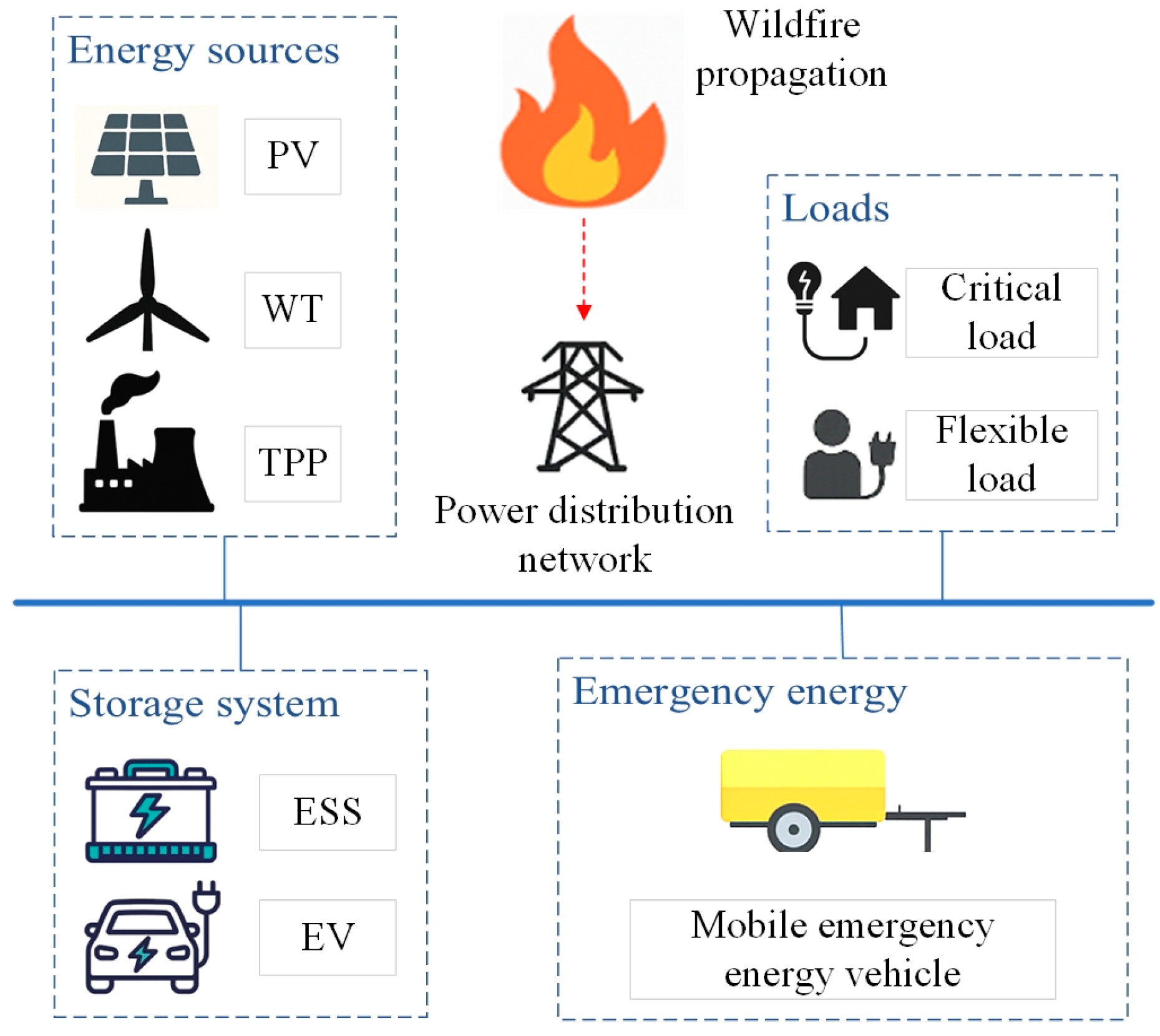



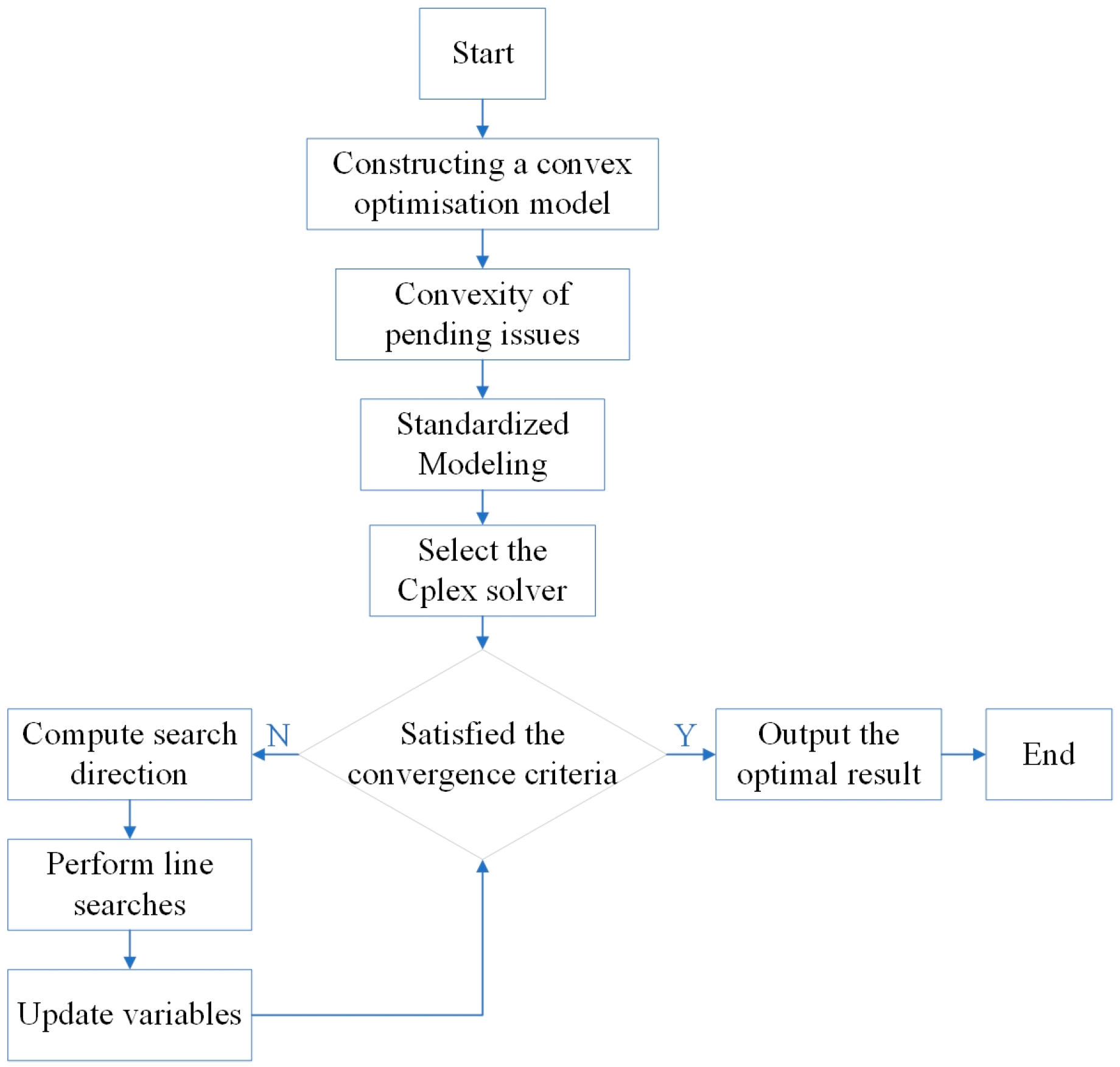


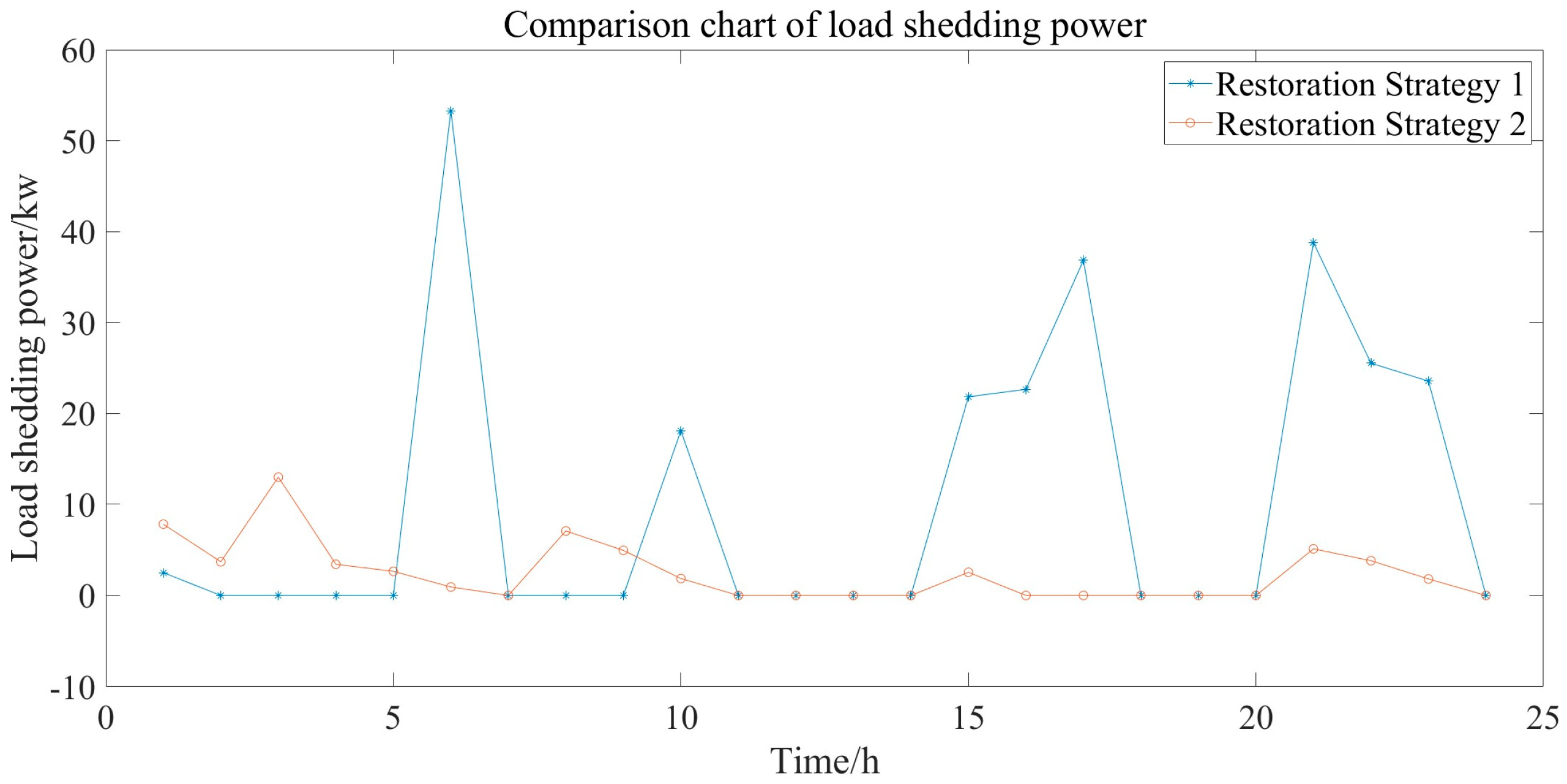

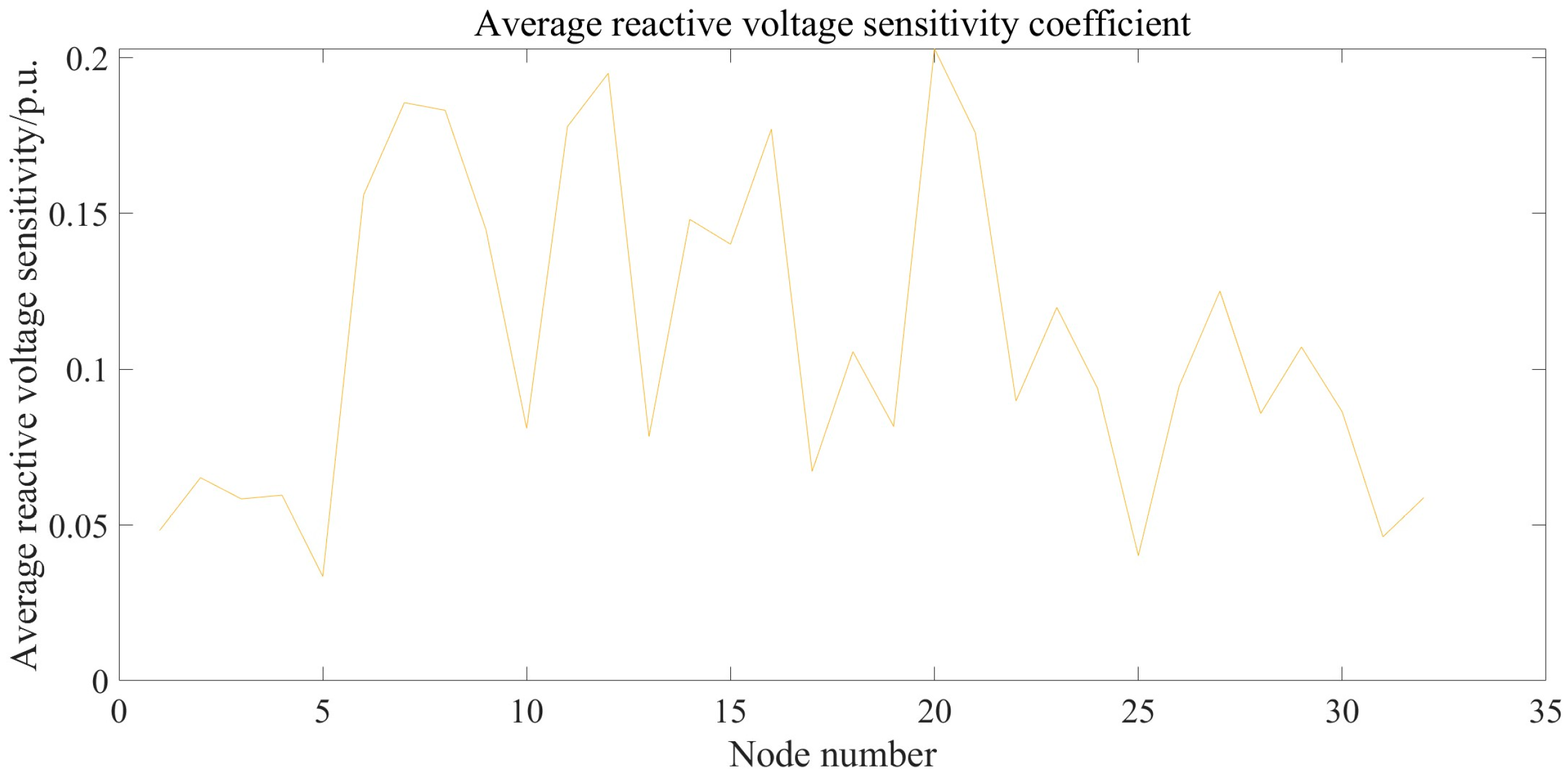
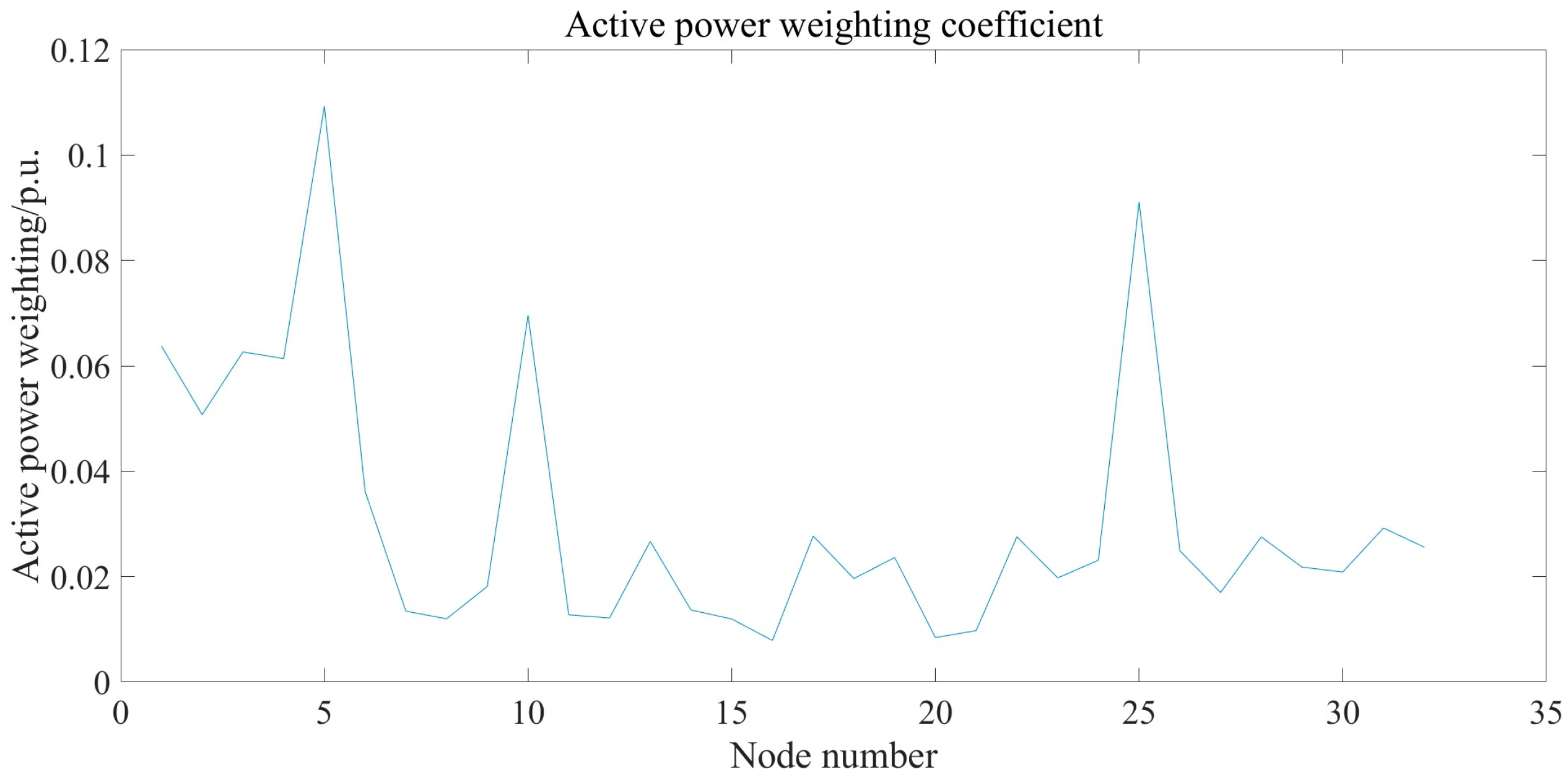
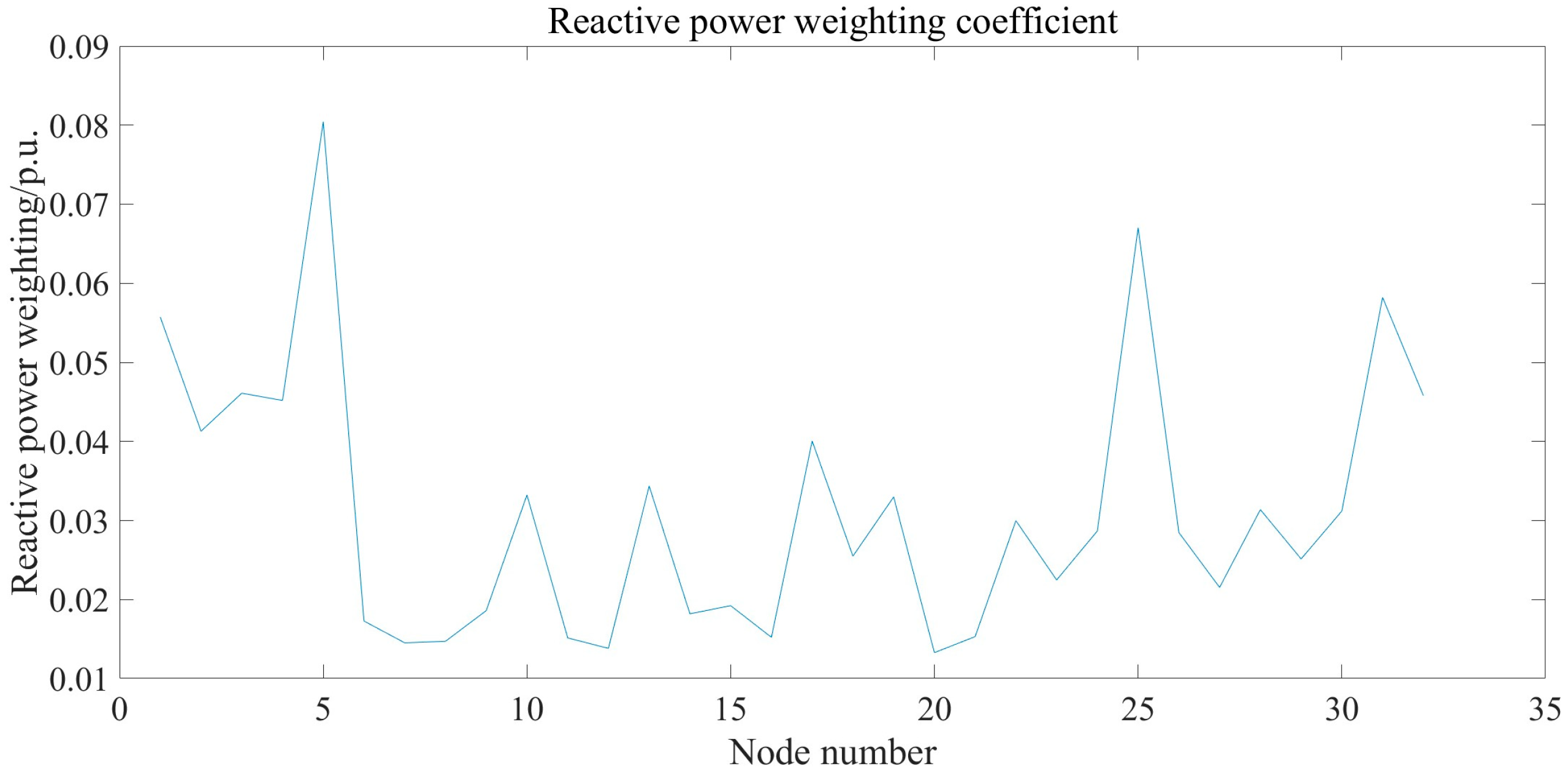
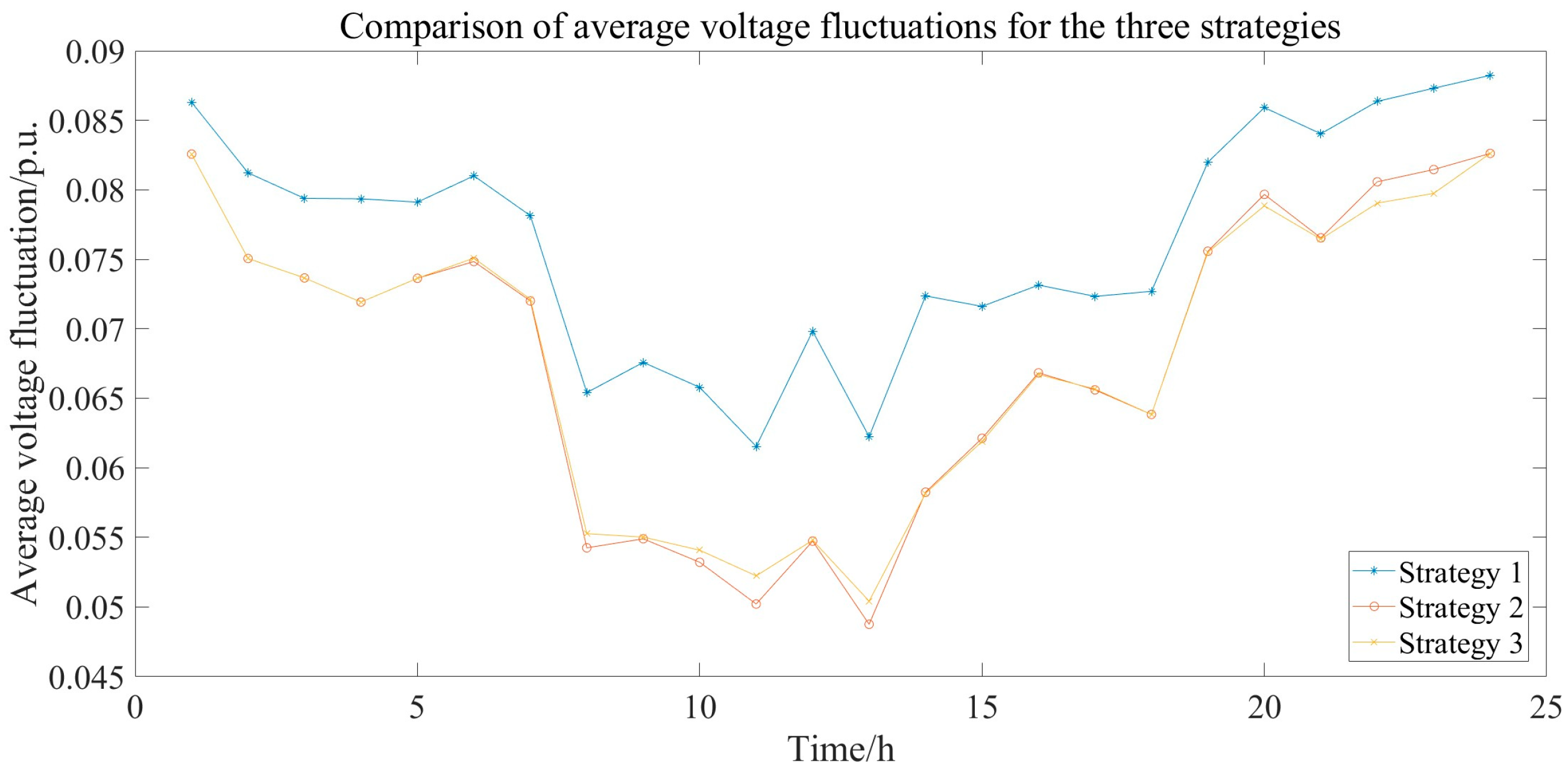
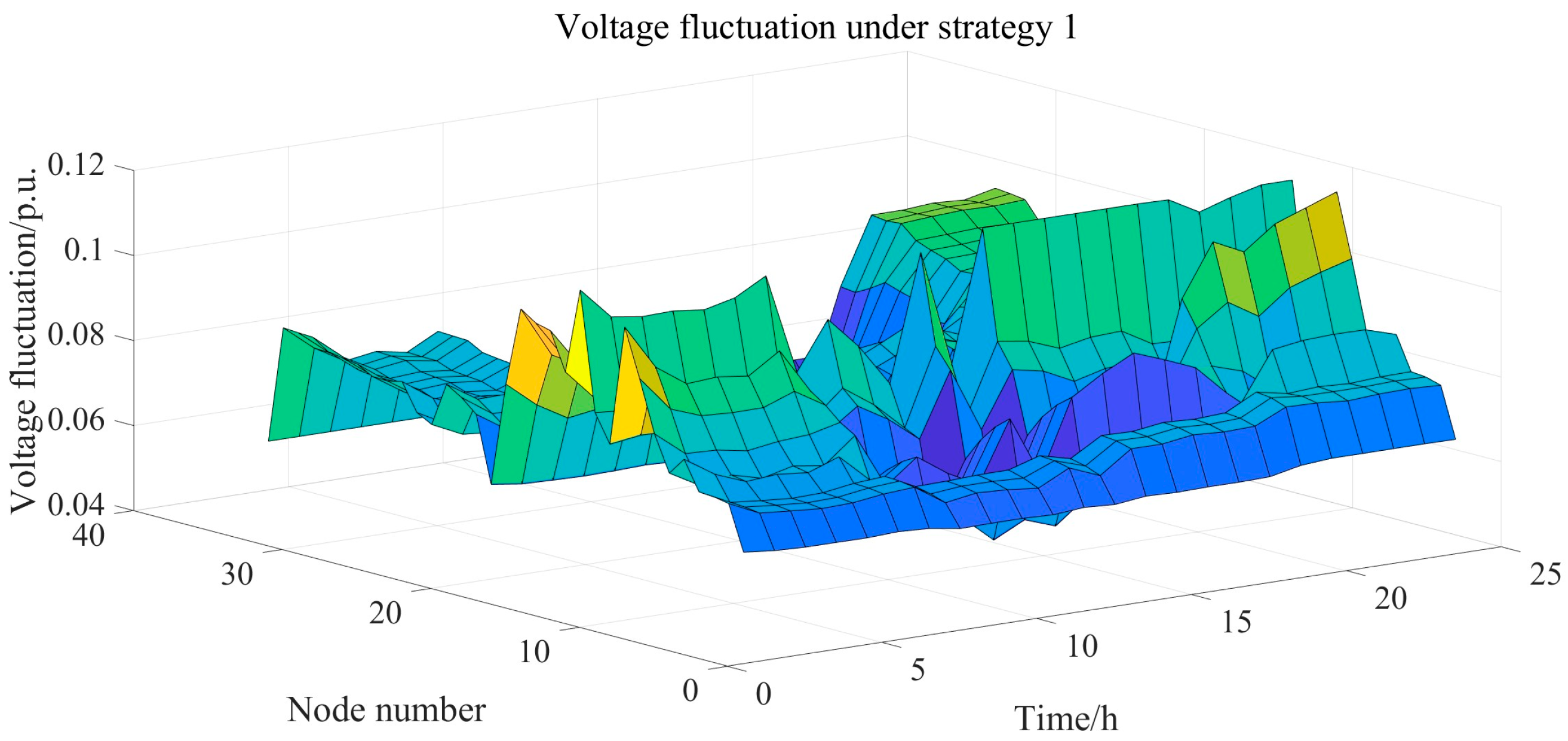

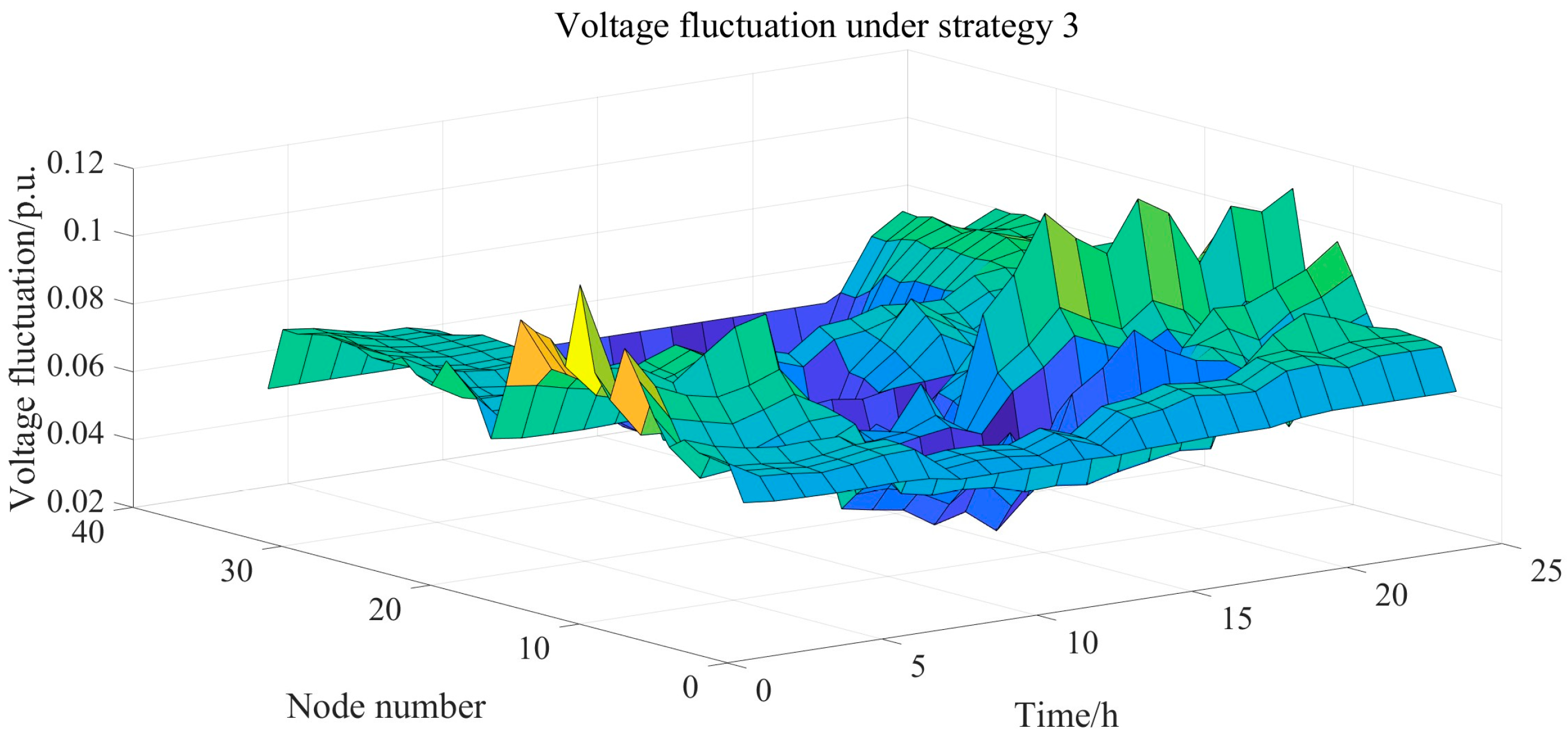
| Restoration Strategy | Cost/USD | Total Cost/USD | |||
|---|---|---|---|---|---|
| 1 | 2 | 3 | 4 | ||
| 1 | 144 | 44,107 | 0 | 9078.7 | 53,329.7 |
| 2 | 154.2 | 43,290 | 5411.8 | 2526.4 | 51,382.4 |
| Strategy | Cost/USD | Total Cost/USD | ||||||
|---|---|---|---|---|---|---|---|---|
| 1 | 2 | 3 | 4 | 5 | 6 | 7 | ||
| 1 | 0 | 0 | 23.5 | 29.9 | 127.7 | 1110.8 | 702.8 | 1994.7 |
| 2 | 207.8 | 143.5 | 18.7 | 0 | 71 | 1097.7 | 0 | 1538.7 |
| 3 | 132.7 | 83 | 0 | 7 | 51.4 | 1098.9 | 0 | 1373 |
Disclaimer/Publisher’s Note: The statements, opinions and data contained in all publications are solely those of the individual author(s) and contributor(s) and not of MDPI and/or the editor(s). MDPI and/or the editor(s) disclaim responsibility for any injury to people or property resulting from any ideas, methods, instructions or products referred to in the content. |
© 2025 by the authors. Licensee MDPI, Basel, Switzerland. This article is an open access article distributed under the terms and conditions of the Creative Commons Attribution (CC BY) license (https://creativecommons.org/licenses/by/4.0/).
Share and Cite
Zhang, J.; Wang, Q.; Zhou, Y. An Enhanced Approach for Urban Sustainability Considering Coordinated Source-Load-Storage in Distribution Networks Under Extreme Natural Disasters. Sustainability 2025, 17, 6110. https://doi.org/10.3390/su17136110
Zhang J, Wang Q, Zhou Y. An Enhanced Approach for Urban Sustainability Considering Coordinated Source-Load-Storage in Distribution Networks Under Extreme Natural Disasters. Sustainability. 2025; 17(13):6110. https://doi.org/10.3390/su17136110
Chicago/Turabian StyleZhang, Jiayi, Qianggang Wang, and Yiyao Zhou. 2025. "An Enhanced Approach for Urban Sustainability Considering Coordinated Source-Load-Storage in Distribution Networks Under Extreme Natural Disasters" Sustainability 17, no. 13: 6110. https://doi.org/10.3390/su17136110
APA StyleZhang, J., Wang, Q., & Zhou, Y. (2025). An Enhanced Approach for Urban Sustainability Considering Coordinated Source-Load-Storage in Distribution Networks Under Extreme Natural Disasters. Sustainability, 17(13), 6110. https://doi.org/10.3390/su17136110






